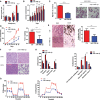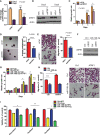Targeting miR-148b-5p Inhibits Immunity Microenvironment and Gastric Cancer Progression
- PMID: 33717068
- PMCID: PMC7944991
- DOI: 10.3389/fimmu.2021.590447
Targeting miR-148b-5p Inhibits Immunity Microenvironment and Gastric Cancer Progression
Abstract
Background: MicroRNAs (miRNAs) have been discovered to dictate the development of various tumors. However, studies on the roles of miRNAs in the progression of gastric cancer (GC) are still lacking.
Methods: Herein, by analyzing GC cell lines and patients samples, we observed that miR-148b-5p was significantly downregulated in GC. We also confirmed that miR-148b-5p overexpression significantly inhibited GC cell proliferation and invasion in vitro and in vivo.
Results: Overexpression of miR-148b-5p not only reprogrammed the metabolic properties of GC but also regulated the immune microenvironment by shifting lymphocyte and myeloid populations. Mechanistically, ATPIF1, an important glycolysis-associated gene, was identified as a direct target of miR-148b-5p and mediated the effect of miR-148b-5p. Notably, the low level of miR-148b-5p was significantly related with poor prognosis of GC patients (P < 0.001). Importantly, the levels of miR-148b-5p significantly changed the sensitivity of GC cells to several anti-cancer drugs (Doxorubicin, P < 0.05, Paclitaxel, P < 0.01, Docetaxel, P < 0.05).
Conclusions: Targeting miR-148b-5p inhibits immunity microenvironment and gastric cancer progression.
Keywords: ATPIF1; gastric cancer; immune microenvironment; metabolic reprogramming; miR-148b-5p.
Copyright © 2021 Zhang, Huo, Sun, Wu, Zhang, Wang, Wang, Wei, Qu, Cao and Jiang.
Conflict of interest statement
The authors declare that the research was conducted in the absence of any commercial or financial relationships that could be construed as a potential conflict of interest.
Figures





Similar articles
-
The role of microRNAs in the gastric cancer tumor microenvironment.Mol Cancer. 2024 Aug 20;23(1):170. doi: 10.1186/s12943-024-02084-x. Mol Cancer. 2024. PMID: 39164671 Free PMC article. Review.
-
miR-148b-3p inhibits gastric cancer metastasis by inhibiting the Dock6/Rac1/Cdc42 axis.J Exp Clin Cancer Res. 2018 Mar 27;37(1):71. doi: 10.1186/s13046-018-0729-z. J Exp Clin Cancer Res. 2018. PMID: 29587866 Free PMC article.
-
MiR-129-5p functions as a tumor suppressor in gastric cancer progression through targeting ADAM9.Biomed Pharmacother. 2018 Sep;105:420-427. doi: 10.1016/j.biopha.2018.05.105. Epub 2018 Jun 4. Biomed Pharmacother. 2018. PMID: 29879625
-
Long noncoding RNA SOX2OT contributes to gastric cancer progression by sponging miR-194-5p from AKT2.Exp Cell Res. 2018 Aug 15;369(2):187-196. doi: 10.1016/j.yexcr.2018.05.017. Epub 2018 May 18. Exp Cell Res. 2018. PMID: 29782828
-
Diagnostic, Prognostic, and Therapeutic Value of miR-148b in Human Cancers.Curr Mol Med. 2022;22(10):860-869. doi: 10.2174/1566524021666211213123315. Curr Mol Med. 2022. PMID: 34961461 Review.
Cited by
-
MiR-363 suppresses the tumor growth of natural killer/T-cell lymphoma via the SIRT6/PI3K/AKT axis.Ann Transl Med. 2022 Dec;10(23):1276. doi: 10.21037/atm-22-5649. Ann Transl Med. 2022. PMID: 36618816 Free PMC article.
-
The role of microRNAs in the gastric cancer tumor microenvironment.Mol Cancer. 2024 Aug 20;23(1):170. doi: 10.1186/s12943-024-02084-x. Mol Cancer. 2024. PMID: 39164671 Free PMC article. Review.
-
Bioinformatics analysis identifies coagulation factor II receptor as a potential biomarker in stomach adenocarcinoma.Sci Rep. 2024 Jan 30;14(1):2468. doi: 10.1038/s41598-024-52397-6. Sci Rep. 2024. PMID: 38291086 Free PMC article.
-
MiR-124-3p impedes the metastasis of non-small cell lung cancer via extracellular exosome transport and intracellular PI3K/AKT signaling.Biomark Res. 2023 Jan 4;11(1):1. doi: 10.1186/s40364-022-00441-w. Biomark Res. 2023. PMID: 36600320 Free PMC article.
-
Evaluation of the diagnostic utility of immune microenvironment-related biomarkers in endometriosis using multidimensional transcriptomic data.J Assist Reprod Genet. 2024 Nov;41(11):3213-3223. doi: 10.1007/s10815-024-03261-z. Epub 2024 Sep 24. J Assist Reprod Genet. 2024. PMID: 39316330
References
Publication types
MeSH terms
Substances
LinkOut - more resources
Full Text Sources
Other Literature Sources
Medical
Miscellaneous

